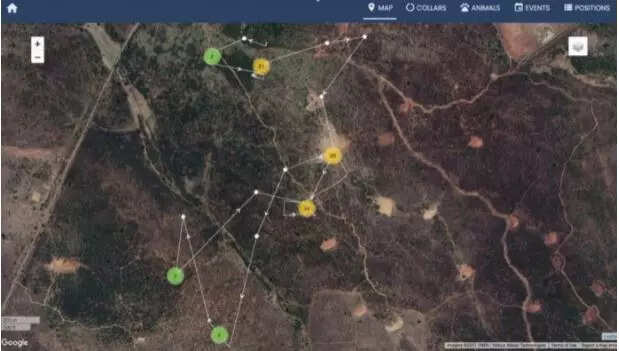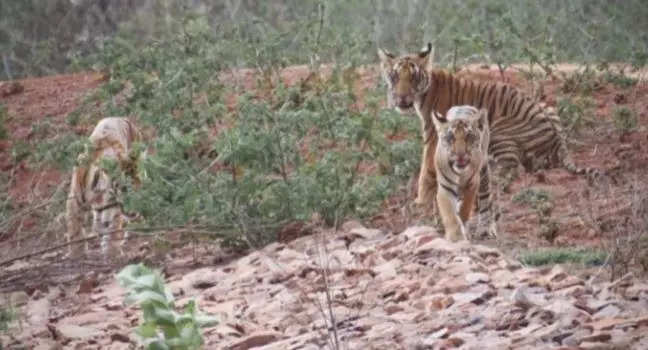For Panna Tiger Reserve staff, it’s like the death of a family member. No one but them understands the bond brothers Heera and Panna shared. PTR officials recall how difficult it was to collar Heera because the brothers were absolutely inseparable — so much in fact that they gave up trying to collar Panna.
They knew the siblings would eventually go their separate ways to rule over their own territories — that’s the law of nature — but no one expected they would be torn apart. In spite of how their sister died.
Siblings Heera P234-31, Panna P234-32 and their sister P234-33 were born in Akola Buffer, a 7,000 hectare patch connecting the core area of PTR. The youngest was run over by a vehicle on Diwali night, November 14, 2020. Now, Heera is dead a week ahead of Diwali.
A few months ago, Panna field director U K Sharma had written a report on the tigers’ familial ties, saying: “The trauma of the tiger family cannot be gauged by us humans. Mother P234 went around making ‘searching calls’ night after night, as reported by field staff.”
Heera was collared after NTCA and the state government permitted radio-collaring 14 tigers in the ‘Panna landscape’ — a term used for around 15,000 sq km in Vindhyan Ranges, covering MP’s Sagar district and UP’s Lalitpur, and extending through Chattarpur, Damoh, Panna and Satna districts of MP, ending in Chitrakoot, UP. This project is being managed by Wildlife Institute of India (WII), which was generating data on movement and spread of tigers in this region to reveal tiger corridors.

“Heera and Panna, being male tigers, have to look for their own separate territory, where they can rule without fear and have at least a mate. Life in the wild is no less challenging. It’s predicted that these two brothers will move out of PTR, and into the Panna Landscape, as there is no possible territory for them in PTR. Akola Buffer is already occupied by three strong male tigers — T7, P111 and P234-21 — and cannot hold any more male tigers. The two brothers will have to displace existing male tigers or embark on a journey,” went Sharma’s report.
Considering this, in December 2020, it was decided to radio-collar these two brothers under the research project. Heera was collared on January 6. “It was quite difficult to collar him as he was with his brother all the time and both of them were still with their mother then,” Sharma wrote.

Forest staff tried collaring Panna on January 11 and 26, but both attempts failed as the brothers could not be separated. Officers decided not to try a third time. It was impossible to separate the duo until three poachers came along with their insidious trap.
Radio collaring of Panna opened the floodgates of information regarding not only his movement but that of his brother. Till December 2020, they were with their mother.
“It was in mid-January 2021 that the brothers were seen alone for the first time. They were on the western side of the state highway, and their mother stayed on the eastern side for more than 15 days with tiger T7, probably to mate, says Sharma’s report.
“It was such a unique experience to see these two brothers, the first time away from their mother. They had not started hunting independently by then. They stuck together, followed the same daily routine and perhaps went without food (some staff say that mother P234 came for a day and made a kill for them and then left again),” Sharma had written.
“One part of the daily routine was coming to the edge of the highway in the late evening, around 7:30pm, and remain there for the next two hours. As news of their daily appearance spread, people from nearby areas thronged to see them. On a lighter note, it seems these two brothers had started enjoying the attention,” he added.
They began hunting independently. “Both of them were regularly seen in Akola Buffer area. It had been opened for tourism nearly a year earlier but was having very poor footfall until it suddenly became a hotspot. Tourists found the tigers very smart, attractive, photogenic and tourist friendly. They would regularly come out on tourism roads in the morning or evening, give delightful photo shoots and entertain tourists in their own ways,” Sharma wrote. That is around the time the names Heera and Panna stuck.
“Though we cannot discount the efforts put up by PTR authorities in developing tourism here in such a short period, the real credit goes to the two brothers, whose ratings as superstars remained supremely high during the whole summer season,” goes his report.
In June 2021, when tourism in the PTR core area, was opened after being closed for one and half months due to Covid lockdown, more tourists still flocked to Akola buffer.
“By mid-July, weekend tourism surpassed all previous records. Both brothers, now nearing 20 months of age, were still together for nearly seven months on their own. It is rare to see such a long association of two male tigers in the wild. It was expected that sooner rather than later, separation will come” the field director predicted.
As expected, Heera began exploring. It was observed moving east. Alone.
On July 24, he was outside the boundary of Akola Buffer and entered the North Forest division. Panna hasn’t been seen since.
“It was clear. The separation had come. It was natural and as predicted, but still heartbreaking,” Sharma wrote, noting that it was a heartbreak for tourists and a setback to tourism in Akola.
Footfall dropped. Heera continued on its eastward trek, out of Panna’s boundaries.
And then it stopped.
In its dying agony, did it look for his brother? The thought break foresters’ hearts.


